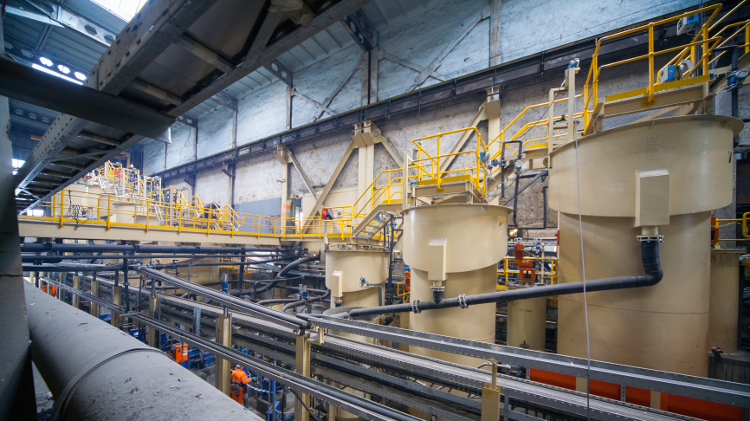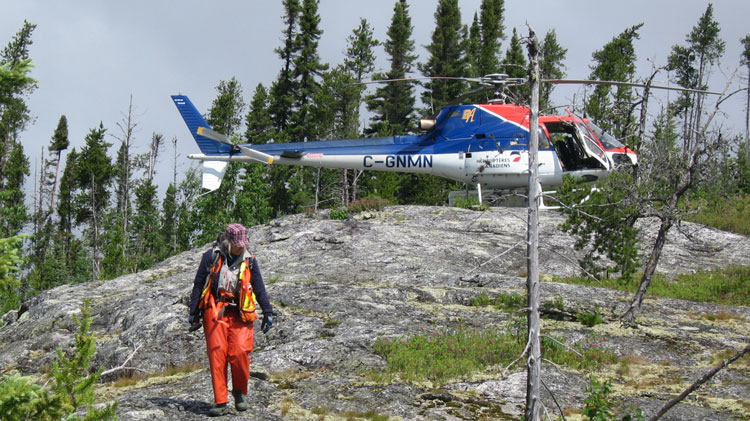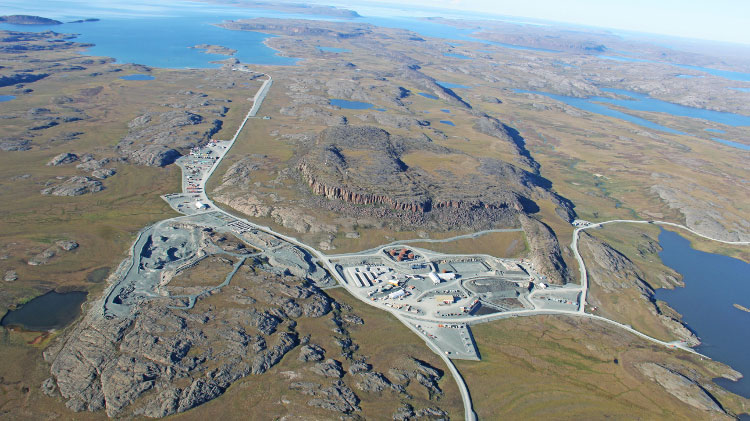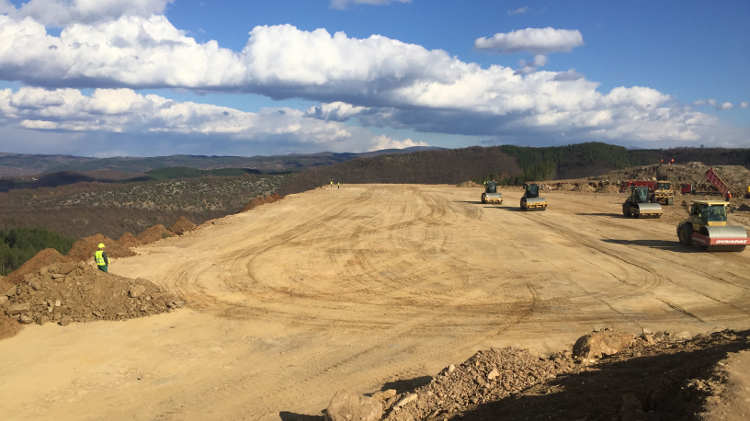The new Bulgarian gold mine under construction by Dundee Precious Metals looks modest on paper. At an annual throughput of up to 840,000 tonnes over eight years and Proven and Probable gold reserves of 807,000 ounces, the open-pit Krumovgrad project is much smaller than Dundee’s first investment in Bulgaria, the Chelopech Mine (“Underground achiever,” CIM Magazine, September 2014).
But reaching this point required persistent effort and creative thinking on the part of Dundee’s management. Krumovgrad is Bulgaria’s first greenfield mine in 40 years, and Dundee responded to the ensuing challenges with innovative solutions and standard-setting practices. “This whole process was a matter of us listening very intently to the community and addressing concerns in a constructive way,” said Paul Proulx, senior vice-president of corporate services at Dundee.
The project centres on Ada Tepe, a low-sulfidation epithermal gold-silver deposit a few kilometres south of the town of Krumovgrad, close to the Krumovitsa River in the Rhodope Mountains. Mining in Ada Tepe started some 3,500 years ago, but over time subsistence farming and forestry came to dominate local land use.
With its 2005 feasibility study, Dundee initially envisioned a carbon-in-leach plant that would produce gold/silver doré bullion. Tailings would be stored in a conventional facility.
But the proposed use of cyanide “generated such negative sentiment in the local and regional communities that the project was stalled for several years,” said John Lindsay, senior vice-president of projects at Dundee. The company went back to the drawing board and in 2011 came up with a new design that eliminated that concern and several others. With permits finally secured, construction started in late 2016. Startup is scheduled for the second half of 2018.
The biggest change is that the new design uses a flotation process rather than cyanide leaching, at the expense of an eight to 10 per cent reduction in gold recovery. “We gravitated to that as our preferred approach because of the experience and expertise that we had in-house through our Chelopech operation,” said Lindsay. Dundee had successfully introduced Staged Flotation Reactors (SFRs) manufactured by Woodgrove Technologies into its flotation circuit at Chelopech and will do the same at Krumovgrad. SFRs reduce floor space and associated capital costs, while offering potentially better power efficiencies compared with more conventional flotation cells.

The processing plant will include staged flotation reactors similar to these installed at the company's Chelopech operation. Courtesy of Dundee Precious Metals
At Krumovgrad, crushed ore will go through a SAG mill and a vertical mill. After an initial round of flotation, the primary flotation concentrate is reground in another vertical mill, prior to final concentrate upgrading in the cleaner flotation circuit. The gold is very finely distributed, necessitating a grind size of 30 microns. In order to minimize the project footprint, Dundee decided to produce concentrates for sale to a third party rather than refine the metal further.
Watch: Developing the staged flotation reactor
That was in part a requirement of the European conservation program Natura 2000, which became law in Bulgaria during the permitting process. A compatibility assessment found that the original proposal would have significant impacts on rare flora and fauna; that was mitigated by decisions made to reduce the mine’s footprint. Dundee also worked with a herpetological NGO to fence the site and resettle protected species of tortoise outside it. “Now our standard of practice has been recognized by the European Union parliament as the best available practice working in Natura 2000,” said Iliya Garkov, vice-president and general manager for Bulgaria.
Integrated waste management
The redesign also cut out the conventional tailings dam and replaced it with an integrated mine waste storage facility that uses a tenth of the space. Tailings will be thickened to a paste similar to underground backfill, ranging from 56 to 68 per cent solids. Starting at the bottoms of two adjacent small valleys, the tailings will be placed into cells constructed from mine waste rock and progressively rehabilitated with native species as they rise from 300 metres in elevation to 450 metres.
The overburden at Krumovgrad is non-acid-generating, making it a relatively convenient container. The waste rock will be crushed to a variety of sizes, from soccer-ball-sized down to fines, in order to maintain a homogenous mixture that will stay stable and allow internal drainage. In keeping with the mine’s zero-discharge design, any water reporting to the underdrain will be recycled.
“One of the challenges will be coordination of the supply of mine rock to support construction of the integrated mine waste storage facility through the life of the mine,” said Lindsay. “A great deal of detailed planning has been done to optimize the material balance.”
The community had many concerns about the Krumovitsa River, which provides water for drinking and agriculture. “The deposit sits on top of a hill, and at the bottom of the hill is the river,” said Lindsay. “In the original project design, which used cyanide, the process facility was located at the bottom in a flat area, but it was very close to the river.” In its redesign, Dundee relocated the plant to the top of the hill. Dundee also committed to treat any water discharged from the site and to run a six-kilometre pipeline from the treatment plant to a discharge point downstream of the community.
Locating the plant on a hill resulted in a significant earthworks project to develop level areas. Half of the two-year construction timeline and approximately US$52 million is focused on earthworks.
Dundee received the final construction permit for Krumovgrad in August 2016 and site work began soon after. Courtesy of Dundee Precious Metals
Developing relationships
These changes alone did not win over the community of Krumovgrad, where the municipal council was reluctant to move forward with mine development. The project’s operations director, Irena Tsakova, relocated to the community in 2012 to establish closer relationships. Garkov also spent much of 2013 through 2015 in Krumovgrad.
“I asked my guys to prepare a list with everybody who was against the project,” Garkov said. “And I started to talk with those guys and asked them for meetings.”
Garkov chatted with everybody in Krumovgrad. “I’m from a small community here in the Chelopech region,” he said. “Everybody knows everybody, and they know the history of the families for the last thousand years. You show respect, you show that you recognize their concerns and you address them.”
After about a year and a half, Garkov felt that the community had accepted the mine. “I started receiving invitations to go to their houses, to their weddings, and to their celebrations,” he said.
Garkov got there by making promises he knew he could deliver on. Residents of Krumovgrad badly needed employment among young people and feared that Dundee would merely send over employees from Chelopech. “When we started to hire local young people and send them to Chelopech for training, they started to see that yes, we actually follow our promises,” he said.
Dundee now meets every month with the local mayor and with the chairman of the municipal council to update them on the next few months’ activities and hiring. “Of course we publish all these things, but in the small regions it is very important to show respect to the local leaders as well,” said Garkov. “You have to understand what is important for people. Don’t give them or promise them things which are irrelevant for them.”
Dundee committed to hiring 90 per cent of its anticipated 230-person operations workforce from the Krumovgrad region. Since there is little to no mining know-how left there, that meant Dundee would need to train almost all of its employees.
The Chelopech operation, 300 kilometres to the northwest, provides a helpful training ground. More than 50 interns have been hired from its university internship program and have progressed as geologists, metallurgists or mechanics. “Two-thirds of our technical services in Chelopech came from this program,” said Garkov. There are now around 12 students from Krumovgrad training in Chelopech for future positions at the Krumovgrad mine. Most of the Krumovgrad workforce will be trained at Chelopech first.
Building for a short mine life
If ongoing exploration does not extend the life of the mine, Krumovgrad will operate for only eight years. This factored into the way that Dundee constructed the project and made its social commitments.
The startup costs had to be kept low, and Dundee has achieved that with an estimated capital cost of $178 million. At current metal prices, the plan is to finance the project partly through free cash flow generated from its other operations and partly through an undrawn committed revolving credit facility, with a small contribution from existing cash on the balance sheet.
The on-site electrical rooms and some satellite offices will be modularized – assembled in shipping containers in major urban centres where skilled labour is readily available. The electrical rooms will be assembled, wired and tested off site, reducing the number of skilled tradesmen on-site during construction.
With the end of the mine in mind, Dundee made two commitments to its Krumovgrad hires. The first was that they would be qualified when they went to find other jobs. “Everybody everywhere needs good, qualified truck operators or front-loader operators,” said Garkov. “Okay, they will not work in the mine, but they will work on the roads or in civil construction.”
The second commitment is that Dundee will offer other types of job training, such as for agriculture, as the project comes to the end of its life. “We’re still thinking about these things,” Garkov said.
Archaeology
In order to be cleared for mining rights, Dundee paid for an archaeological study conducted by the Bulgarian National Institute of Archeology and Museum. The dig found 17.5 tonnes of ceramic artifacts and ancient mining tools amid the stone foundations of buildings from the time. Back then, mining methods were simpler: the miners heated the rock, cracked it by applying cold water, smashing the ore with tools made from rock, and then heated it again in a crude smelting process.
But in the last 40 years, said Garkov, “The country forgot what it means to develop a new mine.” For him, the opportunity to open Bulgaria’s first new mine in decades, and its first-ever mine to operate in a Natura 2000 protected area, was the most rewarding part of the process. That entailed challenges – administrative capacity and familiarity with mining had disappeared, while distrust of the mining industry remained. “At the same time,” said Garkov, “that is an opportunity for you to do things the right way in the beginning.”






